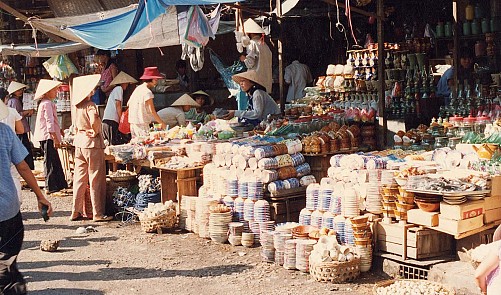Editor's Note: Stivi Cooke is an Australian expat who has lived in Hoi An Ancient Town, located in central Vietnam, for six years.
I often joke that the two national pastimes of Vietnam are sleeping and shopping.
Shopping at your local market is not just a way of life here – it’s part of the ‘Van Hoa’ (culture) that tourists come to experience. However, the world of the small local traders is increasingly coming under threat, not just in Ho Chi Minh City or Hanoi, but Da Nang in the central region as well.
Tuoi Tre News recently reported on the plan by Da Nang City to turn the Han and Con markets into modern, deluxe shopping centers. That’s got local traders worried about their future, and speaking as an expat living in central coastal Vietnam, I’m not in favor of the idea.
All cities thrive on a mixture of the old and new. Most cities have modern supermarkets and shopping centers, but also support the idea of smaller, local markets, which are friendlier and more ‘fun’, as well as a landmark to meet at, go shopping at, or to meet your friends and have a coffee in an informal setting. Heck, I love going to the markets just for the chaos!
It’s almost a human need to have crowded, noisy places full of energy and people milling around. Not to mention the convenience of pulling up on your motorbike, running in, grabbing something for the family and whizzing off in a mad puff of exhaust fumes!
When you visit Ho Chi Minh City, it’s almost obligatory to check out Ben Thanh Market, or the Hanoi night market, known as Dong Xuan Night Market, in the capital city. Regardless of how we label these places, they are communal gathering grounds, settings with traditional links that can’t be compared with the notion that improving the setting of a market is the way of the future.
Diversity and variety (not necessarily always the same thing) are the lifeblood of a thriving city. Aren’t there enough modern shopping centers already in Da Nang? Consider the loss of the tourist dollars if the markets are relocated to less profitable and attractive areas.
The Han Market, for example, looks out to the river and has great views of Da Nang’s spectacular bridges. It’s worth also thinking about their value as tourist attractions and places with character, instead of the soulless sameness of a ‘modern venue’. Why would tourists want to tromp through a multi-story center no different to what they have at home?
I can’t really agree with the idea that Da Nang must have a ‘deluxe trade center’ (to quote the Tuoi Tre News article) to be an international tourist city, or that tourists really want to go somewhere more expensive and less fun than the markets.
The original meaning of the English word ‘market’ was not only ‘to buy and sell in a common area’, but also a ‘fair’. A ‘fair’ was a festive, enjoyable meeting place to showcase farm produce that also had entertainment.
Markets are fun. You go there to ‘people-watch’, haggle over a T-shirt, feel the vegetables, and enjoy the colors and sounds and smells. Shopping centers speak the mantra of ‘buy, buy, buy’. A market shouts the joy of participation in a crowd event. Sure, it’s sometimes not so pleasant, getting pushed around, people shouting all around you, and the fun of getting dragged to a small shoe shop when you really wanted to browse the funny hats – but that’s an experience – something to laugh about with your friends later that day. I don’t think I’ve got many great stories about shopping malls…
Da Nang’s markets are part of the history and the daily life of thousands of people. They are also the economic lifeblood of a wider range of traders unable to afford the rents and costs in a large center.
I travel up to Da Nang at least four times a week from Hoi An, and I’ve noticed that the largest group of road users on the coastal highway are the tough, stocky mums roaring up to Da Nang with two huge bamboo baskets slung on either side of their bike, piled to the top with all manner of goods to trade in the central city. There’s no doubt they are heading for the traditional markets to parley with the stall owners.
We call this a ‘knock-on’ effect, when more people are affected by a change than just the main groups involved. What effect would there be on the rural population near Da Nang who rely economically on the markets for a living if the traders can’t open a shop in a center? Not to mention the loss of all the street trade in food and drink.
Surely there is another way. Is there another location to build a modern trade center with an office block on the river? Yes, further down the river. The new center would also have a transport impact if it’s in the heart of the city, and putting it further away from the city center is unlikely to affect its economic success, since there would be tourist buses rolling up there anyway.
And which would be better to reply with when someone asks, “What do you have that’s interesting in your city?” “Oh, we have a shopping center” or, “Well, we have the markets!”?

























































